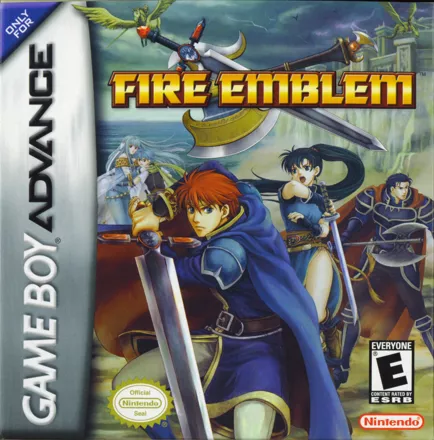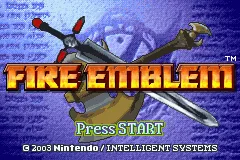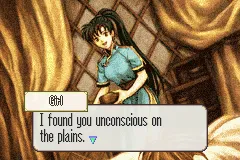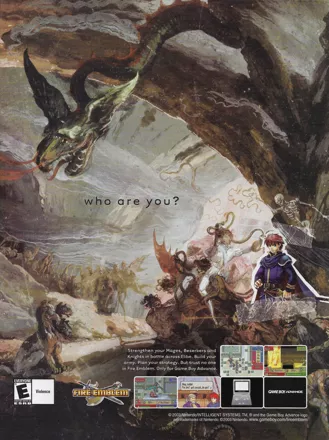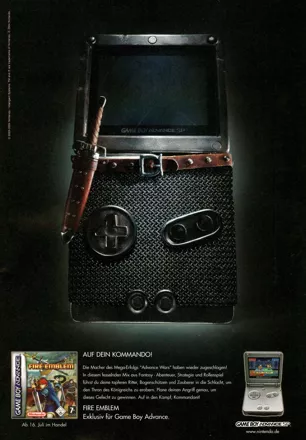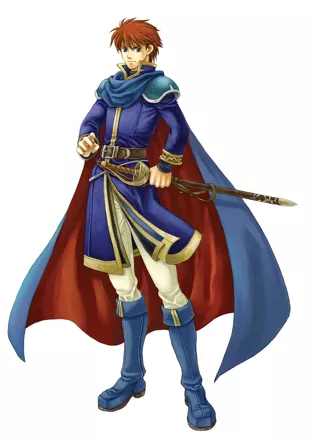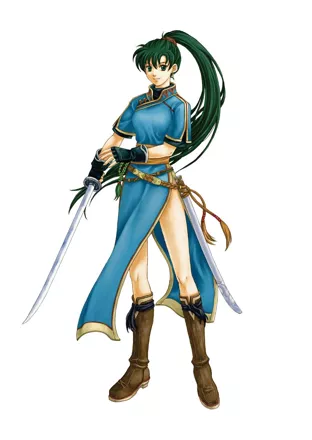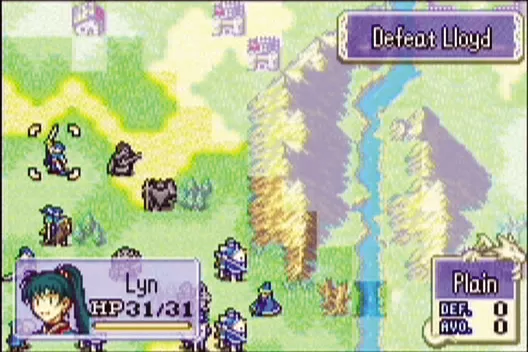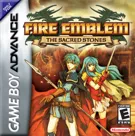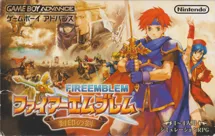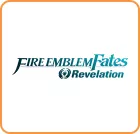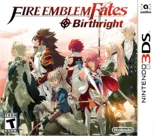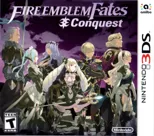Fire Emblem
Description official descriptions
The rightful heir to the throne of Lycia is finally returning home after many years lost to her people. But before the celebrations can begin, you must first guard her through the evil lands that await before you, by taking charge of an elite group of soldiers possessing skills unlike any other.
The first Fire Emblem title to be released outside of Japan includes an all new quest featuring a selection of warriors, wizards and dragons (both good and bad). Battle through turn-based environments and choose your moves wisely, as those you lose during a fight will be lost for good.
Spellings
- ファイアーエムブレム 烈火の剣 - Japanese spelling
- 火焰之纹章:烈火之剑 - Simplified Chinese spelling
Groups +
Screenshots
Promos
Videos
See any errors or missing info for this game?
You can submit a correction, contribute trivia, add to a game group, add a related site or alternate title.
Credits (Game Boy Advance version)
75 People (64 developers, 11 thanks) · View all
| Executive Producer | |
| Producers | |
| Supervisor | |
| Product Manager | |
| Directors | |
| Coordinator | |
| Main Program | |
| Program | |
| AI Program | |
| Program Support | |
| Scenario | |
| Scenario Support | |
| Main Design | |
| Face Design | |
| Graphic Chief | |
| Event Graphic | |
| Graphic Design | |
| Graphic Support | |
| Sound Composition | |
| [ full credits ] | |
Reviews
Critics
Average score: 86% (based on 48 ratings)
Players
Average score: 3.9 out of 5 (based on 64 ratings with 7 reviews)
The thought process of each battle, explained
The Good
Fire Emblem's mechanics are based on numbers and calculations. You're always doing calculations in your head. Since Advance Wars is a well-known game similar to Fire Emblem, I'll make some comparisons to that game in this review. In Advance Wars, your HP is somewhere between 1 and 10. Before each battle, you can roughly predict how much HP each unit will lose. The key word here is "roughly", because it's not shown on the screen. In Fire Emblem however, you know precisely how much HP each character will lose if they are hit. But they will not always be hit; it's possible to attack a unit and miss, dealing 0 damage. A lot of the fun is in this uncertainty: Will my guy hit? Will the enemy miss? This is the biggest reason why Fire Emblem is so much fun to play and replay and replay over and over. You're always nervous and excited about the outcome of the next battle.
Before each battle, there are 12 numbers you will look at. You will use these 12 numbers to make most of your decisions: Do I attack this enemy unit or not? Which weapon do I equip? Where do I place the characters?
The 12 numbers are: Your HP, Attack, Defense, Hit Rate, Critical Rate, Speed, and the same six attributes of your enemy.
The thought process of each battle:
-
Look for wounded characters and a) Heal them. b) Move them outside of enemy units' attack range. c) You can also move them into a defensive terrain type (such as forest), so that the enemy will probably miss and deal 0 damage. It's really more exciting than it sounds: Place a character in a forest and wait for the enemy to attack them and nervously watch the result. But don't do this with the three protagonists because it's game over if they die. d) Rescue them with another character. e) Ignore the injury if no enemy units nearby can kill your wounded character soon. (You know this by looking at the 12 numbers I mentioned.)
-
Move your character next to an enemy unit and view the attack screen. The game will display the 12 numbers. a) The first thing to do here is to compare the Speed. If [your speed - enemy speed > 3] , you will attack twice. Occasionally [enemy speed - your speed > 3] which will make the enemy attack you twice. Speed is a hugely important factor in Fire Emblem. The lead female character Lyn has high speed and everytime you work with her you will consider this. b) Calculate how much HP the enemy has left if you hit. This is [enemy HP - (your attack - enemy defense)]. c) Calculate how much HP you have left if he counter-attack and hit. This is [your HP - (enemy attack - your defense)]. d) If [enemy critical rate > 0], calculate how much HP you have left if he is lucky enough to score a critical strike. This is [your HP - (enemy attack - your defense) * 3]. e) Do this with all the enemy units that are nearby (you can see each enemy's attack range), in order to make sure that when it's the enemy's turn, they can't kill your character. It sounds like a long process but as you play more levels, you can do all the calculations in a few seconds.
-
Improve your strategies by equipping different weapons, using different characters to attack different enemies, and a variety of other options. For example,
a) When you equip different weapons, [you and your enemy's hit rate and attack] can change. [Critical rates and speed] can change too but that's usually not important. You want to have a reasonably high hit rate. If your strategies are good, you'll often get a 100% hit rate, but that takes away some of the fun in Fire Emblem. You already know the result before it happens. Boring. b) When you place your character in a special terrain type, [enemy hit rate] will decrease. The possible outcome will be that you can hit him, but he can't hit you back. c) Block the enemy's path with a very-high-defense character. This is often the "General" or "Hector". You'll often want to block enemy's path in order to protect your weaker characters.
- The most important factor to consider, during every turn, is "can enemies kill one of my characters during this turn". In Advance Wars, the enemy AI always attacks your APC, so you can use that as a decoy to make enemy units move to a certain location. In Fire Emblem, they brought back the APC -- the enemy AI almost always attacks your weakest characters. If they can kill one of your guys, they'll do so. Therefore you must not give them that opportunity. Make it impossible for the enemy to kill one of your guys. Again, you do this by reading the 12 numbers of everyone nearby.
The good news is that, the game's difficulty is quite moderate, so even if the enemy does kill one of your guys (that's not one of the three protagonists), you can keep playing and you can still complete the game. What this means is that you can choose to play Fire Emblem very casually, without worrying too much. You only start worrying when you play for a high "ranking", or want to complete the higher difficulty modes, and need to keep your characters alive, because you need all the firepower you can get.
- In many levels you want to save the villages from being razed, or save the chest from being opened by enemy thieves. This is among the most exciting objectives in any game. This will add another step in your thought process: try to get to the village/chest quickly. This means that you can't play defensively anymore. You have to send characters deep into enemy territory, and possibly risk getting killed. Because of this risk, it adds a whole new layer of suspense to this experience. The best moments of Fire Emblem are being exposed to enemy fire, without getting killed. It's a wonderful feeling.
The Bad
Some important rules are never explained so you need GameFAQs (but you'll probably want to read FAQs either way since it's a turn-based strategy game with so many spells and items). Some in-game text is misleading. For example, it suggests that "steel" weapons are better than "iron" weapons, which is incorrect. Overall, the game does a fantastic job at teaching you how to play, so, only nitpicking here. The real problem with Fire Emblem is the unfocused nature of its character development. You'll have about 30 characters in your army. There aren't nearly enough experience points to properly develop these characters. The ideal strategy is to choose around 6 characters and use them exclusively (plus the 3 protagonists you're forced to use), ignoring everyone else. But that doesn't work quite well either. Because the campaign gives you a new character every two chapters or so. The new character is already stronger than the ones you have developed for a while, making your old characters much less useful, and making you wonder "why did I bother developing my characters, if the game will just give me a stronger one eventually?"
Another small problem is also in the character development section. Some characters level up VERY slowly. It's never explained or hinted. Isadora for example gains very few experience points when she attacks enemies -- that doesn't feel too good. Why does the game discourage players from using certain characters? There is justification for this: The game is trying to tell us that in the real world, not everything is rewarded equally. When you get deeper into the higher difficulty modes, this will become so overwhelming. The game is really trying to say something here. Some characters just level up faster. It's unfair and it's just life.
The Bottom Line
Like all turn-based strategy games, it's entirely a matter of whether you understand and like the mechanics or not.
Game Boy Advance · by Pagen HD (146) · 2013
The perfect balance of fun and strategy...
The Good
Fire Emblem 7, the first game to make it to the shores of the USA. This game is virtually flawless. All of the characters have deep storylines in them, and I found myself having affinities with quite a few of them. This is the game that stars Roy's father, NOT Roy. Every weapon is perfectly balanced. The weapons triangle adds a nice twist of strategy. The realistic factor of not being able to revive the dead adds difficulty and more strategy. This game is better than Final Fantasy tactics Advance by far, since it actually requires thought.
The Bad
Hmmm... Some parts were tedious, but nevertheless fun. The not-being-able-to-revive-the-dead thing also makes the game too hard for some people (cough, cough, FFTA fans). Some might find the storyline cheesy and cliched, but that's the translator's fault.
The Bottom Line
If you own a GBA, go buy this game now. I'm serious. Don't go for FFTA, go for Fire Emblem. The graphics rule. The gameplay rules, The storyline rules. Blinking portraits and animated characters rule. The sprites are awesome. Just go buy Fire Emblem.
Game Boy Advance · by Lad Holyman (3) · 2004
One of the most immersive games ever
The Good
This game sucks you in right from the beginning. The tactician role was perfect, although the game overglorifies the player sometimes. The story is great, with it's many plot twists and tragedy and drama. All in all, it's balanced, has a decent difficulty, and replayability is great, as you try to get all of the CG's.
The Bad
Well, the fact it's on the gba as a 2D strategy game irks me, because it would have been SOOOO sweet if it was a fully fledged 3D rpg game on the Gamecube, complete with cinematics and graphics. (oh and the char. dies no revive irks me too)
The Bottom Line
dude, just go buy the game and enjoy the immersiveness of it!!!
Game Boy Advance · by Maceart BeefKing (6) · 2004
Trivia
References to the game
Lyn appears as an assist trophy in the Wii game Super Smash Bros.: Brawl.
Version differences
The introduction music features a voice in the Japanese and American version of the game. The European version of the game has the melody played by a flute instead. Most probably they needed more space for text in different languages, and they removed the voice to gain more space.
The Kingdom of Bern was renamed Biran in the French and German translations of the game, probably because the capital of Switzerland and its region is also named Bern, which could create confusion amongst some gamers.
Awards
- GameSpy
- 2003 – #5 Game Boy Advance Game of the Year
- 2003 - Revival of the Year (Game Boy Advance)
Information also contributed by Sciere
Analytics
Upgrade to MobyPro to view research rankings and price history! (when applicable)
Related Sites +
-
Fire Emblem
Official game web site by Nintendo of America.
Identifiers +
Contribute
Are you familiar with this game? Help document and preserve this entry in video game history! If your contribution is approved, you will earn points and be credited as a contributor.
Contributors to this Entry
Game added by Kartanym.
Wii U added by Michael Cassidy.
Additional contributors: Unicorn Lynx, chirinea, Exodia85, gamewarrior, Bregalad, Patrick Bregger, Hengki Kusuma Adi.
Game added December 1, 2003. Last modified January 14, 2025.


